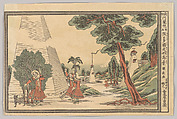“The Pyramids of Egypt” Egefutekoku senkei kodai), from the series Newly Published Dutch Perspective Prints (Shinpan Oranda uki-e)
Utagawa Kuninaga Japanese
Not on view
This woodblock print with a fanciful depiction of the Great Pyramid of Giza is from a series that seems to have originally intended to illustrate the Seven Wonders of the Ancient World, though only five designs are known, and the artist clearly did not have reliable illustrative models for all the famous sites. The other four designs include:
Colossus of Rhodes;
The Tomb of Mausolus
Statue of Zeus at Olympia;
Hanging Gardens of Babylon.
The title indicates that this is a series of uki-e, literally “floating prints”—usually translated as “perspective prints”—which was the term used to refer to a special genre of ukiyo-e that employs the convention of linear perspective of European paintings. Always remaining a bit of a novelty item, perspective prints were first created in the 1730s by Okumura Masanobu, who had studied European engravings to learn the rules of perspective. The engravings he drew inspiration from entered Japan either through the entrepot of Dejima in Nagasaki—where Dutch traders were based, or from China. Masanobu was the first ukiyo-e artist to employ the term uki-e. In the late 1750s, Utagawa Toyoharu fully developed the genre when he produced ukiyo-e copies of engravings after Canaletto and Guardi. Toyoharu was also the first to adapt these techniques to Japanese subjects. The interiors of Kabuki theaters were a common subject in uki-e prints, since such depictions lent themselves well to applying one-point perspective. As demonstrated by this series of prints, ukiyo-e artists enjoyed imagining Western famous sites to test their skills with perspective prints. Such images are filled with anachronisms, such as Dutch visitors meandering around the Great Pyramid of Giza rendered as tall and narrow.
We do not know exactly what sources the artist Kuninaga consulted, but we know that Ferdinand Verbiest (1623–1688), Belgian missionary to China, created an illustrated text in Chinese discussing the Seven Wonders of the Ancient World (七奇図説), published in1683. Verbiest’s essay was circulating among Japanese scholars of Western studies (Rangaku) intellectuals by the eighteenth century. Even if Kuninaga had access to this text, he probably was not referring to Verbiest's illustrated text when he designed this series. He may have been drawing on random pieces of information and an assortment of imported copperplate prints depicting the Seven Wonders, without properly understanding his sources.
Another inspiration for this image can be traced to a detail of the Pyramid of Giza in the border of a world map designed by the celebrated Dutch cartographer Willem J. Blaeu (1571–1638). Blaeu’s Nova Totius Terrarum Orbis Geographica ac Hydrographica Tabula was first printed in 1606, and then continuously published after that. By the eighteenth century, it was most commonly reproduced in book or album formats, and it was probably in this format that it made its way to Japan.
Artist’s signature: Kuninaga ga 国長画
Publisher’s signature: Izumiya Ichibei 和泉屋市兵衛 (Kansendō)
This image cannot be enlarged, viewed at full screen, or downloaded.

